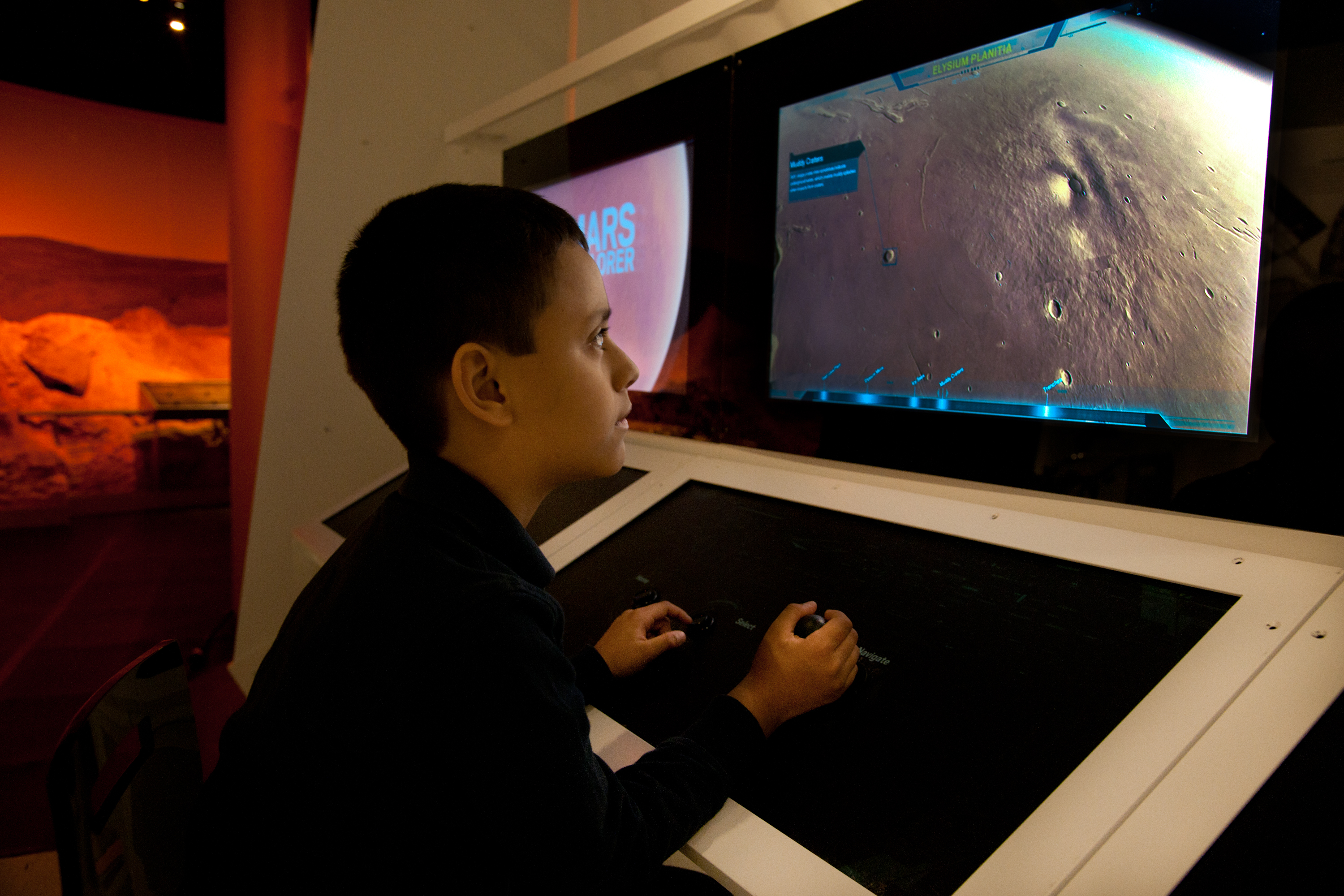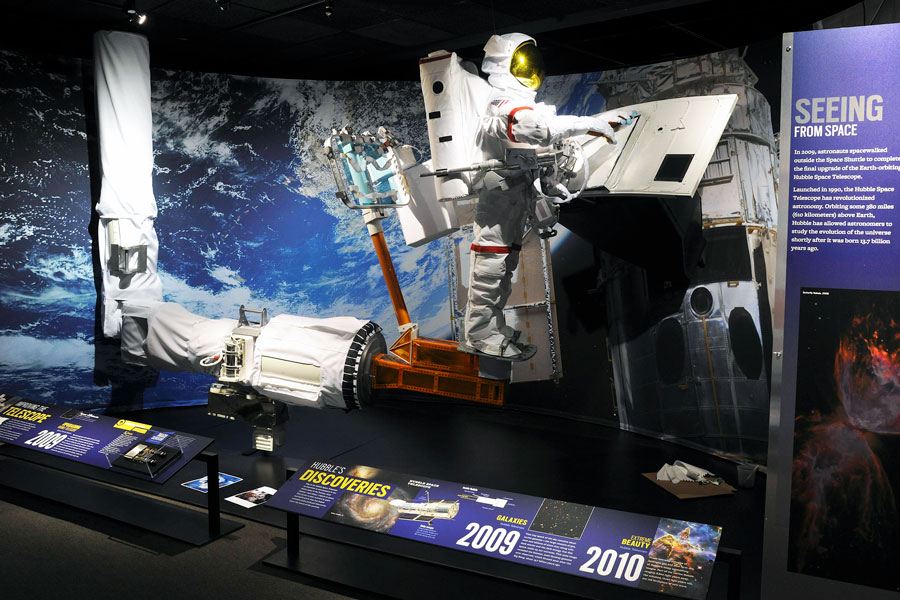New Bullock Museum exhibition imagines the future of space exploration
Family-friendly exhibition launches visitors on missions to the moon, Mars, and beyond
SEPTEMBER 23, 2019 (AUSTIN, TX) — The exhibition Beyond Planet Earth: The Future of Space Exploration, a traveling exhibition from the American Museum of Natural History, is now open at the Bullock Texas State History Museum. The exhibition explores the history and science of space travel and offers a vision of the future of space exploration through life-size models, immersive dioramas, and interactive multimedia.
"Texans have historically played a critical and formative role in the study and exploration of our solar system for decades," said Margaret Koch, Bullock Museum Director. "We're excited to be able to host this experiential exhibition as it inspires us to imagine what our future might look like."
Beyond Planet Earth begins with a retrospective of historic piloted and unpiloted space missions, highlighting the space programs of the United States, Soviet Union and China, NASA’s Apollo missions, the use of robots in space, the International Space Station, the Hubble Telescope, and the rise of space tourism. Visitors will see original astronaut gloves, a lunar tire, full-size models of Sputnik 1 and a Mars rover, and try an interactive that simulates the smell of the moon.
A video presentation introduces visitors to future space missions and a return to the Earth’s moon. Models of lunar habitats and a space elevator examine the ways future missions could transport mined materials and create a liquid mirror telescope on the moon’s surface. Visitors can then try out a liquid mirror telescope for themselves with a spinning liquid mirror interactive.
A recreation of a Japanese spacecraft that rendezvoused with the asteroid Itokawa in 2005 introduces a section highlighting the ways in which we might study, explore, or deflect near-Earth asteroids. Visitors explore asteroids in science fiction and pop culture and discover how we might be able to mine asteroids for valuable metals.
The exhibition continues by imagining voyages to Mars. Visitors will see a full-scale model of the Curiosity Rover, miniature models demonstrating how astronauts might eat, sleep and exercise during a journey to Mars, and test how they would fare on the journey with an interactive personality test. A fly-over simulation gives visitors a sense of the Martian landscape, and a Mars terraforming game allows visitors to transform Mars from a frozen, thin-aired environment into an Earth-like planet.
The exhibition concludes with a look at our next steps into the outer solar system and beyond by exploring how we might search for life on Jupiter’s moon Europa and other distant planets. Visitors can explore more than a thousand stars that have already been found to have planets of their own and ponder the question of whether any of them support life.
"This exhibition has something for everyone: panoramic vistas mixed with in-depth content; entry points regardless of what your background knowledge is; and a huge number of interactive games that put you in control of our next great space adventure," said Koch.
Beyond Planet Earth: The Future of Space Exploration is on view until January 12, 2020. For more information, visit TheStoryofTexas.com.
# # #
About The American Museum of Natural History
The American Museum of Natural History, founded in 1869 and currently celebrating its 150th anniversary, is one of the world’s preeminent scientific, educational, and cultural institutions. The Museum encompasses 45 permanent exhibition halls, including those in the Rose Center for Earth and Space plus the Hayden Planetarium, as well as galleries for temporary exhibitions. It is home to New York State’s official memorial to Theodore Roosevelt, a tribute to Roosevelt’s enduring legacy of environmental conservation. The Museum’s approximately 200 scientists draw on a world-class research collection of more than 34 million artifacts and specimens, some of which are billions of years old, and on one of the largest natural history libraries in the world. Through its Richard Gilder Graduate School, the Museum grants the Ph.D. degree in Comparative Biology and the Master of Arts in Teaching (MAT) degree, the only such free-standing, degree-granting programs at any museum in the United States. Annual onsite attendance has grown to approximately 5 million, and the Museum’s exhibitions and Space Shows are seen by millions in venues on six continents. The Museum’s website, digital videos, and apps for mobile devices bring its collections, exhibitions, and educational programs to millions more around the world. Visit amnh.org for more information.
Downloads
The Bullock Texas State History Museum, a division of the State Preservation Board and an accredited institution of the American Alliance of Museums, creates experiences that educate, engage, and encourage a deeper understanding of Texas. With dynamic, award-winning exhibitions that illuminate Texas history, people, and culture, educational programming for all ages, and an IMAX® theater with a screen the size of Texas, the Museum collaborates with more than 700 museums, libraries, archives, organizations, and individuals across the world to bring the Story of Texas to life. For more information, visit www.TheStoryofTexas.com
The Bullock Texas State History Museum is a division of the Texas State Preservation Board. Additional support for educational programming provided by the Texas State History Museum Foundation.
Media Contact
| General Inquiries | |
|---|---|
| 512-463-5424 | |

